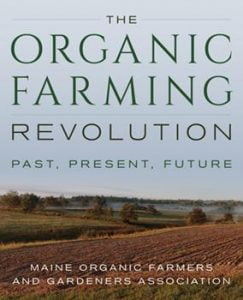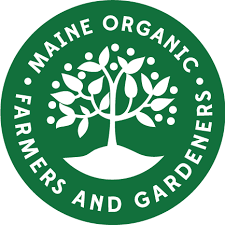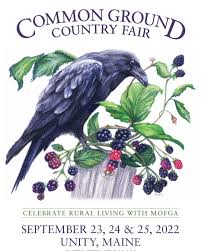This week’s We Are What We Eat column by Todd Chretien reviews the Maine Organic Farmers and Gardeners Association’s The Organic Farming Revolution: Past, Present, Future
Family farms hold a special place in American history as symbols of self-reliance and wellsprings of democratic values from the Populists to Dust Bowl refugees to Back to the Landers to Farm Aid to a COVID-driven explosion of support for local agriculture. However, there’s also a long-running tendency to erase the settler-colonial reality of American farming. Maine, after all, is Abenaki land.
The Maine Organic Farmers and Gardeners Association’s aptly named anniversary volume, The Organic Farming Revolution: Past, Present, Future, takes on the entirety of this contradictory reality. MOFGA offers up a collection of essays exploring the movement’s roots, its current moment in the sun, and how we might reconstruct our corporate-dominated, ecologically suicidal industrial food complex.
Sarah Alexander, MOFGA’s executive director, tackles the question of colonialism early on in her introduction to Revolution: “The people who founded MOFGA did not invent” the principles and practices of organic farming. “They’ve existed in every Indigenous culture that has even lived on the earth, including the Indigenous communities that live in the lands we occupy today.”
Acknowledging that farms in Maine got their start on stolen land and as part of an economy that thrived on slavery opens the door to practical measures for solidarity and reparations as well as unlocking pathways to knowledge and techniques developed by Black and Indigenous farmers. Revolution features dozens of episodes covering a range of topics from soil building and seed gathering techniques to federal agricultural policy, but the best place to start is with the book’s emphasis on Indigenous and Black voices.
Barry Dani, former chief of the Penobscot Nation and owner of Unique Maine Farms, explains that “Sovereignty for Native People is the basis of our values, our foundation in this land, which is our homeland.” Leah Penniman, co-executive director of Soul Fire Farm and author of Farming While Black, next debunks a “dangerous mythology,” one which writes Black farmers out of the organic movement. She traces the origins of Community Supported Agriculture (CSA)—a mainstay of sustainable farms today—to the Tuskegee Institute professor Booker T. Whatley’s “clientele membership clubs.” Revolution gives pride of place to these insights in multiple ways. For example, Muhidin Libah and the staff of the Somali Bantu Community Association of Maine review the work done on Liberation Farms, a farm organized cooperatively by immigrant communities to serve their own and the larger population’s needs in the Lewiston-Auburn area.
Alongside Native, Black, and New Mainer farmers, Revolution recounts the specifics of MOFGA’s own history and principles as well as hot button debates among farmers. Jean English and Eric Sideman offer a succinct definition of organic agriculture as a “system that maintains and builds soil health.” They go on to share part of a MOFGA’s origin story, describing it as a joint effort in 1971 between back to the landers—many of whom were inspired by Scott and Helen Nearing and their book Living the Good Life—people from the University of Maine and its Cooperative Extension program, and “about twenty others,” who met in 1971 to found the group. Eliot Coleman, an organic winter farming trailblazer and ingenious toolmaker working at Four Seasons Farm, weighs in with an “old time opinion,” criticizing a tendency among farmers to rely on organic, but commercially produced fertilizer inputs, in favor of “doubling down on the old-fashioned, organic style of home-grown, self-reliant, unpolluted, non-mechanical, low-cost, soil fertility creation and maintenance.”
Other contributors, such as Quebecois market gardener Jean-Martin Fourtier, take a different approach, emphasizing the practicality of certain commercially available organic pesticides and fertilizers and light tillage (as opposed to no till or heavy till), especially for new farmers who aim to make a living from what he calls “human-scaled agriculture” on just a few acres. Debates like these abound, grounded in practical growing experience and an eye towards the challenge of scale and pushing back the boundaries of corporate agriculture. If you’re new to these debates, don’t be scared! Revolution explains the terms and points you in the right direction for further reading if you get hooked.
Maybe most compellingly of all, Revolution puts our ecological crisis—as I write, a January snowstorm is turning to rain—front and center, while addressing the closely associated question of building community and political constituencies around farming. Chellie Pingree, Maine’s Congressional Representative for the First District and herself a farmer, points to the Agricultural Resilience Act she has sponsored, whose objective is to cut agricultural greenhouse gas emissions by 50% in the next decade and achieve net-zero carbon emissions by 2040. Needless to say, there’s not a snowball’s chance in (global warming) hell that it will pass without a movement powerful enough to defeat Big Ag. And although many organic farms (especially in Maine) are family farms that rely on little or no hired labor, nationally, “Big Organic” rests on many of the same anti-immigrant, anti-union practices that dominate global commercial agriculture. Right here in Maine, Gov. Janet Mills’s recent veto of farmworker legislation shows we have to clean up our own house. As Ian Yaffe, who represents Mano en Mano, notes in Revolution, “Maine has a choice for the next fifty years beyond focusing on organic food production: truly welcoming farmworkers into our communities and providing the respect that is necessary…”
Revolution suggests an all-encompassing approach that centers Indigenous sovereignty, anti-racism, immigrant rights, feminism, ecology, farm worker organizing, cooperatives, Community Supported Agriculture, local food in our schools, and a consciousness that the movement cannot simply aim to exist on the periphery of our industrial food complex. It must challenge it and, eventually, replace it. It is an appeal to young people to become farmers. And those new recruits will not be alone. In her contribution to the books, Severine von Tscharner Fleming of Smithereen Farm reminds us that Maine has the highest per capita number of young farmers in the country. At the same time, hard experience has taught veterans that a “hippie swarm” cannot replace sustainable growing and labor practices. Barbara Damrosch, author and co-owner of Four Season Farm, drives home the point. “If the organic farming revolution is going to work, it can’t be built on volunteerism, or on exploitation. Those of us who mentor the next generation of young farmers must show them how to make a decent living doing it.”
Anyone fighting for a better world on any front will profit by its accumulated wisdom, perhaps best summed up by Damrosch: “Smart workers pay attention to detail, anticipate the next step, and keep their eyes open. They close the gates behind them and notice when the sun has come out and the greenhouse needs venting. They ask questions, probing their mentors for knowledge.”
Words to live by, words to organize by, words to farm by.
*****
The Organic Farming Revolution: Past, Present, Future ($34.95).
Featuring essays by: Sarah Alexander, Eli Berry, Wendell Berry, John Bunker, Eliot Coleman, Barbara Damrosch, Barry Dana, Niaz Dorry, Jean English, Severine von Tscharner Fleming, Jean-Martin Fortier, Rowen Gorman, Sam Hayward, Elizabeth Henderson, Amber Lambke, Muhidin Libah, Russell Libby, Karyn Lie-Nielsen, Kirsten Lie-Nielsen, Mort Mather, Daniel Mays, Kathleen Merrigan, Nicolette Hahn Niman, Leah Penniman, Chellie Pingree, John Piotti, Abby Rockefeller, Bonnie Rukin, Beth Schiller, Barton Seaver, Eric Sideman, Deb Soule, Rowen White and Ian Yaffe




